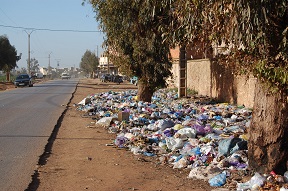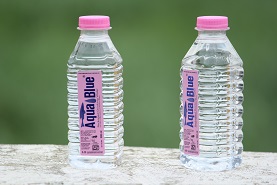Mankind needs to set a clear goal: plastic waste should no longer exist in ten to fifteen years from now. This ambitious goal needs to be tackled from two sides: plastics design on the input side, and dedicated processing on the output side. Circular design concepts and professional reprocessing, including clever collection schemes, should help us reach this; and the industrial manufacturers should show us the way.
This is the first of two articles on the reduction of plastic waste. The articles were published on 3 December and 6 December 2017.

The need for clear targets in plastic waste reduction
We do not have to dwell long on the importance of the plastic waste problem. According to the Plastic Soup Foundation, global plastics production amounted to 311 million tons in 2014, with an annual growth rate of 8%, meaning that this amount will double every 10 years. About half of that is single-use plastic and is thrown away immediately after use; worldwide people throw away more than one million bags a minute. We have only a faint idea of their long-term effects on the environment. For us, there can only be one solution to this problem: reduce the amount of plastic waste discharged to the environment each year, with the aim to reduce this to zero – we think that with existing and new technologies, the goal of zero waste can be reached in 10 to 15 years. A goal to which we can contribute in our private lives as well.
Mankind produces two kinds of products. The first kind is meant to be released into the environment: toothpaste, food, pesticides, toilet paper. We need to make sure that in the environment, these products will degrade quickly to environmentally harmless molecules; if not, then no marketing and no sales. The second kind is meant to be durable: plastics, computer chips, metals, cars. For these, there needs to be a cycling loop: before the product is marketed and sold, we need to specify how it will be processed in its end-of-life phase, and take adequate measures to make sure that this will be done properly. If the producer cannot meet these criteria: again, no marketing and no sales.
Prevention of plastic waste
The advantage of ambitious and clearly stated targets is that they allow a better view on actions to be taken. In the light of our goal, ALL plastic objects should be produced with their end-of-life option in mind. Logically, there are just a few options:
- Reuse, i.e. return of the object in its original function
- Recycling,
- from a pure fraction assembled after use
- from a mix with other plastics or even with other waste
- Biodegradation, i.e. decomposition into biocompatible compounds
- Destruction, primarily by incineration and use of the energy generated.
In order to achieve this, we need to rethink plastics: bring to the forefront that the end-of-life phase is as important as the design for its original function.
We therefore need to rethink the entire plastics chain. Starting with plastics design. Until now, there was just one criterion in plastics design: how well the plastic would fulfil its designated function. Like being lightweight and strong, for computer packaging. Or like having excellent gas barrier properties, for beverage bottles and food packaging material. Mankind needs to add a new criterion: what will be done with the plastic in its end-of-life phase. This it is a formidable task, but with the proper incentives it is not at all beyond our reach. First, we should formulate the long-term target, the dot on the horizon. Then, formulate design criteria for acceptable plastics, together with the plastics industry. Finally, devise proper policy measures that will make sure that our targets can be met.

Plastic waste policy
In the next column, we will go into the demands that this process will make on chemists and on chemical technology. Here, just a few words on the organization of a successful plastics cycle. For plastics that remain in an industrial or closed cycle, the organization of a return scheme is relatively easy, and in many countries return rates are high already. But for plastics released in an open cycle that involves the general public, successful return rates will require a deposit on plastic objects. Deposit schemes for plastic bottles are highly successful, with return rates over 80%, in some countries even over 98%. A deposit lends a value to plastic objects; and even if someone would throw away the plastic bottle, someone else might pick it up and collect the deposit. For the same reason, we should extend the deposit scheme to beverage cans. If we would also impose a general deposit on all plastics, this would even lend a value to unsorted plastic waste. In most countries, the beverage industry and retail companies oppose mandatory deposit schemes – too cumbersome, too little space in our supermarkets. But then, would they prefer mankind to continue littering the planet, at a pace that doubles every decade?
Recently, the Ellen MacArthur foundation drew much attention to the problem of plastic waste. In 2016 by publication of a manifesto ‘New Plastics Economy’, and early 2017 by publishing a more action oriented brochure ‘New Plastics Economy, Catalysing Action’. The Ellen MacArthur Foundation is an important player, as it is supported by many major companies. It fulfils the important function of sensitising the business community to the need for a circular economy; it puts problems like that of plastic waste on the agenda, and formulates many important actions to be undertaken, like their recent call to ban oxo-degradable plastics. But it might need to state more clearly the goals of its new plastics economy. In terms of the business community that it addresses: identify the dot on the horizon. Like: phasing out plastic waste in 10 to 15 years.
Change economic incentives
There is a strong economic reason for the continuous production of plastic waste: plastics are too cheap. A deposit will correct this unfortunate state of affairs. The coming circular economy requires mankind to specify the end-of-life option for each and every plastic object produced. Of course, these ideas are ambitious and seem to be farfetched. Their realisation will require political courage. But in 1850 Mark Twain already said: ‘The man with a new idea (back then, women did not exist yet) is a Crank until the idea succeeds.’
P.S. Latest news: the resistance of supermarkets to a deposit scheme is fading away.
Written together with Alle Bruggink and Ton Schoot Uiterkamp.
Interesting? Then also read:
New Plastics Economy: circular, not yet biobased
New study reports that in Europe, biodegradable plastics growth is in the bag
Plastic litter: strict regulation is the only remedy
